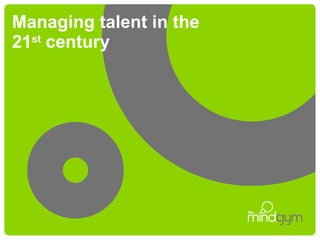Managing Talent in the 21st Century
•Descargar como PPT, PDF•
5 recomendaciones•1,705 vistas
1) Talent management is about developing all employees, not just a select few. It involves identifying high potential individuals and helping them advance in their careers. 2) Implementing an effective talent management program can significantly increase a company's profits. A 10-point improvement in talent management practices could add $70-160 million to a Fortune 500 company's bottom line over 2-3 years. 3) Old talent management approaches had short-term focus and minimal performance management. New approaches make it difficult to enter the program but provide support, opportunities, and recognition to help participants succeed and be retained long-term.
Denunciar
Compartir
Denunciar
Compartir

Recomendados
Recomendados
Más contenido relacionado
La actualidad más candente
La actualidad más candente (20)
21st Century Talent Management: Imperatives for 2014 and 2015

21st Century Talent Management: Imperatives for 2014 and 2015
McKinsey & Company : Talent Management and Knowledge Management

McKinsey & Company : Talent Management and Knowledge Management
Saba - Bersin by Deloitte - Performance Management in the 21st Century

Saba - Bersin by Deloitte - Performance Management in the 21st Century
The top 15 strategic things that Talent Management should be doing

The top 15 strategic things that Talent Management should be doing
Simply Irresistible: Engaging the 21st Century Workforce

Simply Irresistible: Engaging the 21st Century Workforce
Talent Management for Talent Managers: HR Competencies for 2013 and Beyond

Talent Management for Talent Managers: HR Competencies for 2013 and Beyond
Building a Business Case for a Talent Management Suite

Building a Business Case for a Talent Management Suite
Get Em Keep Em Grow Em: a Texas BBQ of Integrated Talent Management

Get Em Keep Em Grow Em: a Texas BBQ of Integrated Talent Management
Making Performance Management Work - 10 Keys to Success

Making Performance Management Work - 10 Keys to Success
Strategic Partnerships to Infuse Technology in Student Affairs

Strategic Partnerships to Infuse Technology in Student Affairs
Best Practices in Recruiting Today - High-Impact Talent Acquisition

Best Practices in Recruiting Today - High-Impact Talent Acquisition
Destacado
One Page Talent Management and the 4 + 2 Model of Talent Manager Excellences

One Page Talent Management and the 4 + 2 Model of Talent Manager ExcellencesThe Talent Strategy Group
Destacado (20)
Todi presentation 2012 measuring roi talent development preso kim

Todi presentation 2012 measuring roi talent development preso kim
Planning for the Future - Growing talent and Succession Planning

Planning for the Future - Growing talent and Succession Planning
August 2016 – Edge Talk: Managing Talent in Health and Social Care

August 2016 – Edge Talk: Managing Talent in Health and Social Care
An Intro to Talent Development and Talent Analytics

An Intro to Talent Development and Talent Analytics
One Page Talent Management and the 4 + 2 Model of Talent Manager Excellences

One Page Talent Management and the 4 + 2 Model of Talent Manager Excellences
Metric Driven Talent Management - 21st Century Talent Management Conference T...

Metric Driven Talent Management - 21st Century Talent Management Conference T...
Similar a Managing Talent in the 21st Century
Similar a Managing Talent in the 21st Century (20)
Managing Talent In The 21st Century_extended version

Managing Talent In The 21st Century_extended version
Boardroom agenda for FY16-17: priorities and actions

Boardroom agenda for FY16-17: priorities and actions
Do People Resist Change March 2015 talk at the Association for Project Manage...

Do People Resist Change March 2015 talk at the Association for Project Manage...
Improving Employee Performance by Mirza Yawar Baig

Improving Employee Performance by Mirza Yawar Baig
HR's role in this recession and the coming recovery

HR's role in this recession and the coming recovery
Attract, Retain, and Grow your people to grow your impact and the role of lea...

Attract, Retain, and Grow your people to grow your impact and the role of lea...
Último
Último (20)
Unlocking the Future: Explore Web 3.0 Workshop to Start Earning Today!

Unlocking the Future: Explore Web 3.0 Workshop to Start Earning Today!
Organizational Structure Running A Successful Business

Organizational Structure Running A Successful Business
Corporate Profile 47Billion Information Technology

Corporate Profile 47Billion Information Technology
International Business Environments and Operations 16th Global Edition test b...

International Business Environments and Operations 16th Global Edition test b...
Digital Transformation in the PLM domain - distrib.pdf

Digital Transformation in the PLM domain - distrib.pdf
8447779800, Low rate Call girls in Kotla Mubarakpur Delhi NCR

8447779800, Low rate Call girls in Kotla Mubarakpur Delhi NCR
Investment in The Coconut Industry by Nancy Cheruiyot

Investment in The Coconut Industry by Nancy Cheruiyot
8447779800, Low rate Call girls in Tughlakabad Delhi NCR

8447779800, Low rate Call girls in Tughlakabad Delhi NCR
Cybersecurity Awareness Training Presentation v2024.03

Cybersecurity Awareness Training Presentation v2024.03
NewBase 19 April 2024 Energy News issue - 1717 by Khaled Al Awadi.pdf

NewBase 19 April 2024 Energy News issue - 1717 by Khaled Al Awadi.pdf
8447779800, Low rate Call girls in Uttam Nagar Delhi NCR

8447779800, Low rate Call girls in Uttam Nagar Delhi NCR
Japan IT Week 2024 Brochure by 47Billion (English)

Japan IT Week 2024 Brochure by 47Billion (English)
Managing Talent in the 21st Century
- 1. Managing talent in the 21 st century
- 3. The prize A 10-point increase in an average Fortune 500 company's talent quotient score will add between US$70 million and US$160 million to the firm's bottom line over the next two to three years. Hewitt Associates.
- 7. How to identify this? Source: Deloitte (2008)
- 10. What is it that’s difficult? Matt Pease and Simon Mitchell, Leaders in Transition: Stepping Up, Not Off. DDI.
- 12. KPIs for talent programmes Source: Deloitte (2008) Source: Deloitte (2008) Other